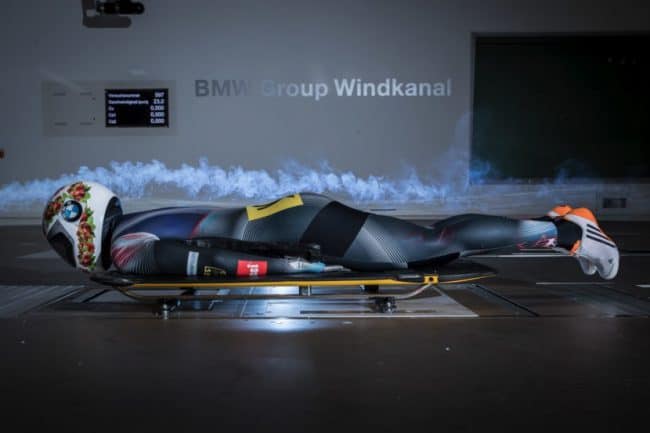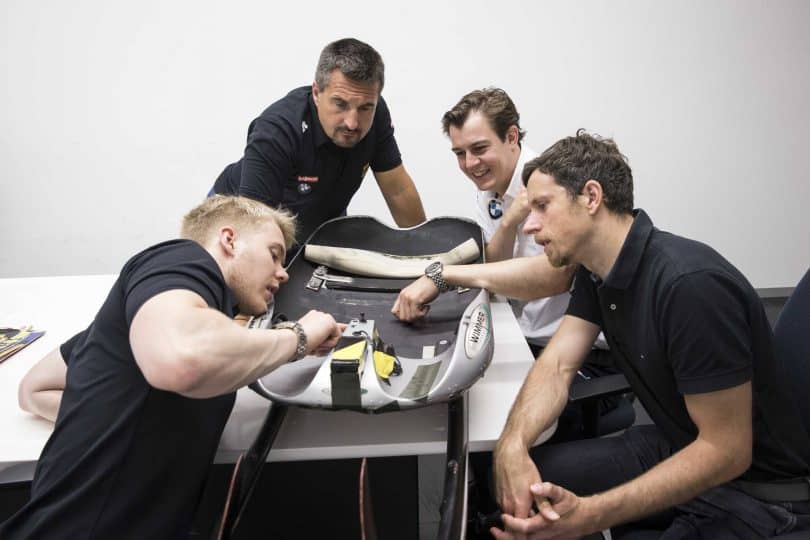It is the “magic word” for success in racing, whether on asphalt or in the ice channel: the ideal line. Just over a year ago, BMW Motorsport engineers adapted state-of-the-art measurement and analysis technology from the racetrack for use in sledging. With the data collected since then, luge riders from the Bobsleigh and Sled Association for Germany (BSD) analyze and optimize their rides with great precision in order to be optimally prepared for the Olympics.
Deviations from the ideal line are precisely analyzed using motorsport measurement and analysis technology.
Initiator and Junior World Champion Julian von Schleinitz as well as Olympic champion Felix Loch collect data in about 100 test drives.
Munich. It is the “magic word” for success in racing, whether on asphalt or in the ice channel: the ideal line. Just over a year ago, BMW Motorsport engineers adapted state-of-the-art measurement and analysis technology from the racetrack for use in sledging. With the data collected since then, sledders of the Bobsleigh and Sled Association for Germany analyze and optimize their rides with high precision in order to optimally prepare for the ice track of the Olympic facilities in Pyeongchang.

The technology transfer from automobile to toboggan racing encompasses a multitude of sensors that are also used in BMW Motorsport vehicles: Acceleration, yaw rate and temperature sensors thus help to precisely reconstruct the journey. This system makes it possible to compare different runs and to analyze them in extremely high resolution, since several measurements per second are recorded. Until now, only the split times, the subjective feeling of the athletes and the experienced eye of the coaches were available in the luge.
The initiative goes back to luge junior world champion Julian von Schleinitz, who, in addition to his active career as an athlete in the summer, successfully completed his master’s degree in materials science. He recognized the potential and asked BMW Motorsport for support in the area of measuring technology.
BMW Motorsport engineer Sebastian Meyer has implemented the system into a racing sled and, together with Schleinitz, the three-time Olympic champion and world champion Felix Loch and toboggan coach Georg Hackl, has developed and collected valuable data. “Felix and I completed around 100 trips with the system on board this year. Except for the routes in the US and in Sigulda, we have collected all the World Cup tracks with the sensors – including Pyeongchang, “reports von Schleinitz. “In particular, we looked very closely at the key point – Curve 9 – and gained a lot of interesting insights.”
In luge sport it is very difficult for the athletes with his enormous G-forces and speeds to recapitulate the driving line exactly after the finish line. The measurement technique helps to verify the feeling: why was the ride fast or slow? Which line was especially good? Where did mistakes happen? In a sport in which thousandths of a second decide on gold, silver and bronze, every little thing is important. With the BMW measuring technology, the lugers receive detailed information about the influence of their start and control movements on the acceleration and speed of the sled. Also in the search for the ideal line as well as in the calculation of the ice friction – which is physically very complex and still not fully understood – many new possibilities open up.
“This system is an objective judge over the entire journey and gives us the opportunity to analyze the narrow border area exactly,” says von Schleinitz. “We can compare and see several trips from Felix and myself, which was the one who, by chance, hit the ideal line and how it came about. That’s a tremendous amount of information we’ve gathered over the past 12 months. ”
Another advantage of the system provided by BMW Motorsport: if the driving line is under control, material tests can be much more meaningful, because the effect of the material is not distorted by another line. In order to make this possible, von Schleinitz has written a software with which the data from the sensors can be read for specific sledges. Because not everything that is relevant in motorsport is also useful for the lugers – and vice versa.
The software has been further developed and optimized by Schleinitz together with Meyer. The BMW Motorsport Engineer says: “Transferring technology into another sport is methodically and analytically always a gain in knowledge for both sides. The new experiences are therefore also useful for our work in motorsport.







